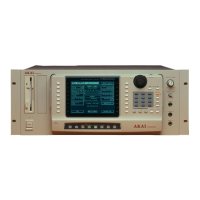Version 1.21 13
s5000
/
s6000
INTRODUCTION
SWITCHING THE S6000 ON
Before turning on the sampler, it’s a good idea to turn its volume down or to turn the volume down
on the amplifier or the mixer channels as the power up ‘thump’, although very slight, could damage
sensitive speakers, especially if the amp is turned up loud (this is good practice when turning the
S6000 off as well).
Now turn on the S6000. You will see the following LCD screen as it boots up:
The icons appearing at the bottom of the screen indicate what hardware is installed.
The icons are:
Shows the sampler’s polyphony
4
.
Shows the amount of memory installed.
Shows whether the EB20 multi-channel effects board is installed.
Shows whether the optional ADAT digital I/O is installed.
Indicates that an external ASCII keyboard is connected.
Those items
NOT
installed will be shown with a ‘X’ through them (e.g. as shown in the above
screen shot for the ADAT board).
4 On an unexpanded S5000, the same icon will be shown but with the number 64 instead.

